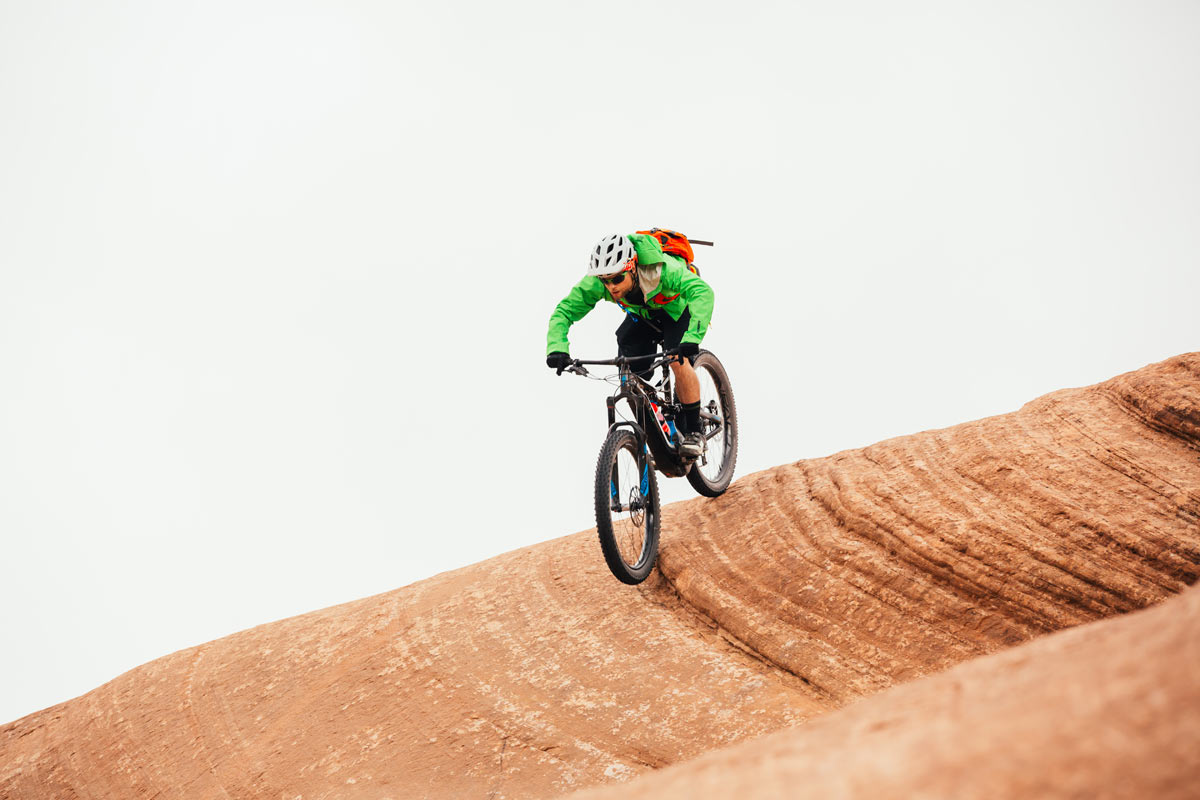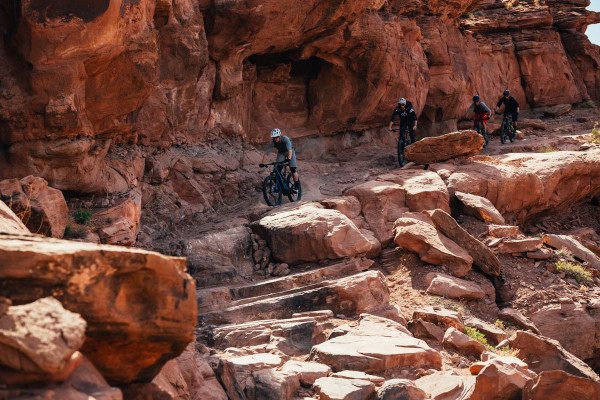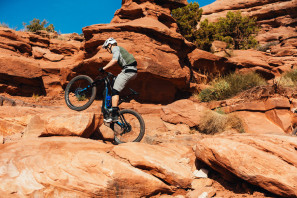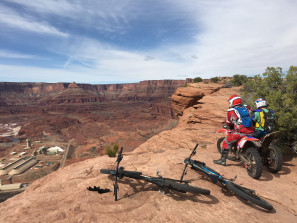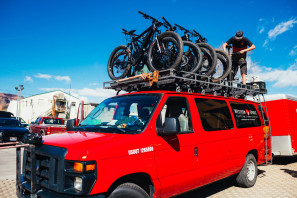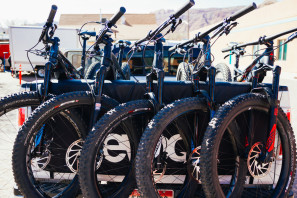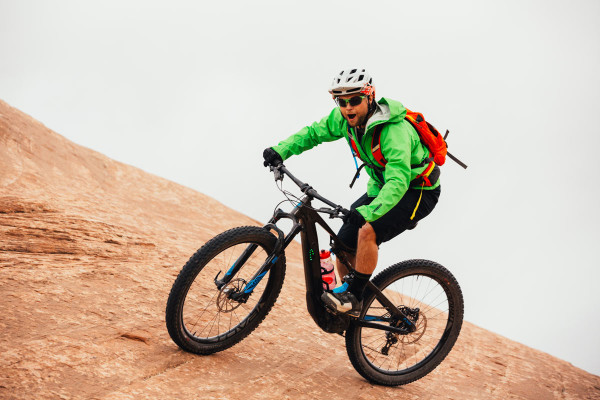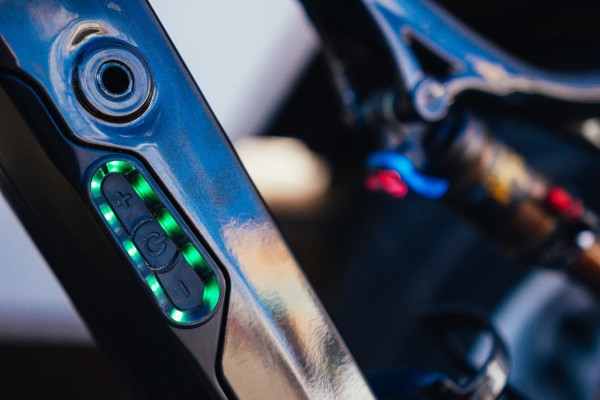
When Specialized first invited us out to Utah, we had no idea what was in store. It was soon revealed however, that we would be headed to Moab to test out the Turbo Levo FSR 6Fattie. Their first full suspension e-mountain bike. Huh.
With mixed emotions, we accepted the opportunity as a chance to at least have first hand knowledge on what the bike is – and isn’t. After all, as Einstein is often quoted, “the only source of knowledge is experience.”
So we set out to gain that experience. On e-bikes. On legal trails. In Moab…
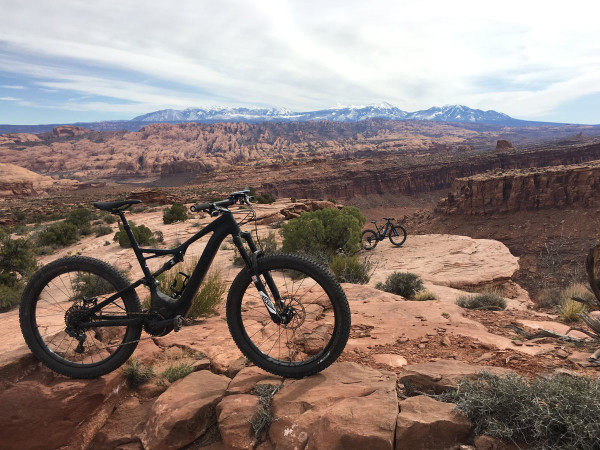
It wasn’t that long ago that I was having a discussion with an employee of Haibike, another brand that sells a lot of e-bikes… Out of genuine curiosity, I inquired what their plan was for the sale of e-mountain bikes in the United States considering you weren’t able to ride them on mountain bike trails. Without missing a beat he said there were plenty of places at that very moment that e-bikes were completely legal to ride off road. He actually chose Moab as an example. While the Moab BLM recently declared that “motor assisted bikes” are illegal to use on any mountain bike trails in and around Moab, it seems to have been missed by many that the ban does not apply to all of the OHV trails that are open to anything from Jeeps to motos. If you haven’t been to Moab, there are far more trails open to motorized vehicles than not. In fact, many legendary “mountain bike” trails (like Slickrock) were actually pioneered by motos and are still open to the motorized set today.
All of this played directly into Specialized’s decision to host this event in Moab. It wasn’t intended to ‘poke the bear’ but rather clear up some misconceptions on the current legality of e-bikes. Also… Moab turns out to be an incredibly fun place to ride an e-bike.
And ride we did.
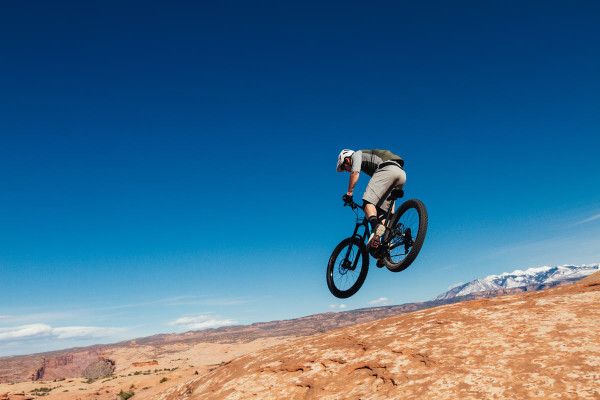
We put more miles on the Turbo Levo in two days than I have on a classic bike (as Specialized likes to call them) here in a week. Brutal, tiring miles. One of the favorite criticisms of e-bikes seems to be that to ride one you would have to be lazy, or weak, or a terrible rider, or hoping to ride without getting a workout. After two days on a Levo here, I was beat. My legs were admittedly in pretty good shape on the return home. My upper body though? I felt like I had been weight lifting for a week. Overall, it actually seemed like more of a full body workout than the leg-intensive workout of a classic bike. There were quite a few points in the rides where we all looked at each other, out of breath with our hearts beating out of our chests thinking, “I thought this was supposed to be easy?”
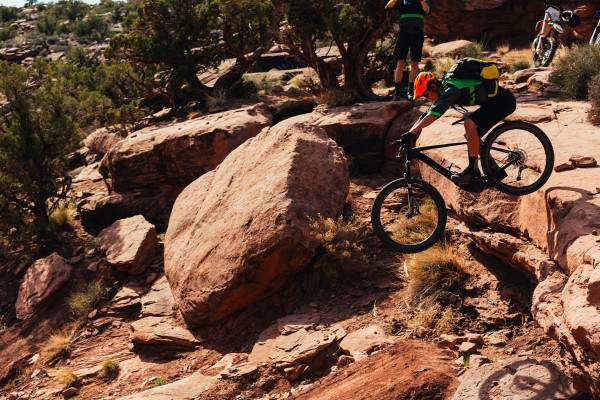
There is no doubt that this was because the motor assist kept our legs feeling more fresh at the end of each ride, which in turn led to more riding. Two-a-days on some of Moab’s most iconic and brutal trails like Amasa Back (from town) and Slickrock Trail. Everything we rode was completely legal for e-bike use which led to some interesting encounters with other trail users. On Amasa Back we ran into a large group of moto riders at a relatively tricky section of trail. As the motos struggled to get their heavy bikes over a boulder strewn climb, we simply picked up the Levos and scrambled up. We didn’t see them again until we had already reached the summit.
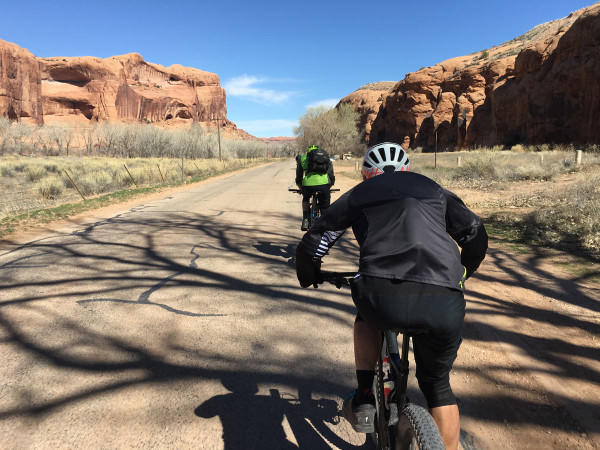
This brings up another argument against e-bikes – they’re so expensive (they’re actually similarly priced to many mountain bikes), why not just get a motorcycle? That ride up Amasa back seemed to be all I needed to answer that question. Don’t get me wrong, I love motorcycles, and probably always will. But I love mountain bikes more. And compared to a motocross bike I found the near silence of the Levo combined with the relative light weight to be more like a bike than a motorcycle. You still have to pedal. You still have to ride it like a mountain bike downhill. It just helps fast forward the flat parts and gives you the ability to ride more trail. Keep in mind that we are talking about pedal assist bikes here – there are no throttles. If you don’t pedal, it doesn’t go.
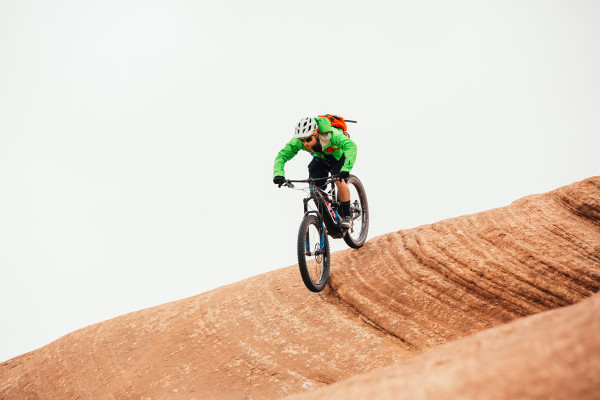
One thing is for sure, the addition of a motor in most cases will not give you super human mountain bike handling powers. It might make you faster on the climbs, but if you don’t have the skills, you will stumble as much (or more) as you would with a classic bike. There are of course some exceptions like Slickrock trail – the combination of endless grip and smooth rolling terrain really will leave you feeling like Superman. But generally, the Levo seems to amplify what is already there. If you are a fast rider, you will be even faster on the Levo. A mediocre rider? You’ll still struggle through the technical sections, but you will probably be a bit faster on the smooth sections.
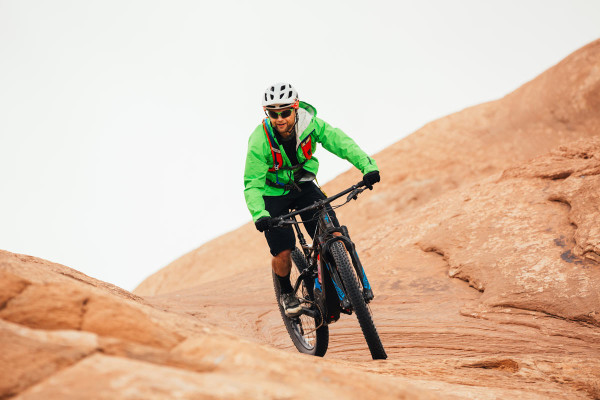
That’s largely due to the fact that the Levo really rewards you for continuously pedaling. That means you really have to pick your lines quickly lest you stop pedaling and the motor bogs down. Then there is the potential for too much power to push the front end or send the bike out of control if you aren’t ready for the boost. There may be some truth to the fear that e-bike riders would suddenly find themselves in a situation where they are way over their head, but more likely they would have turned back long before they got to that point. The 6Fattie’s big contact patch certainly helped to stay planted to the trail, but it still requires just as much skill to pilot at high speeds.
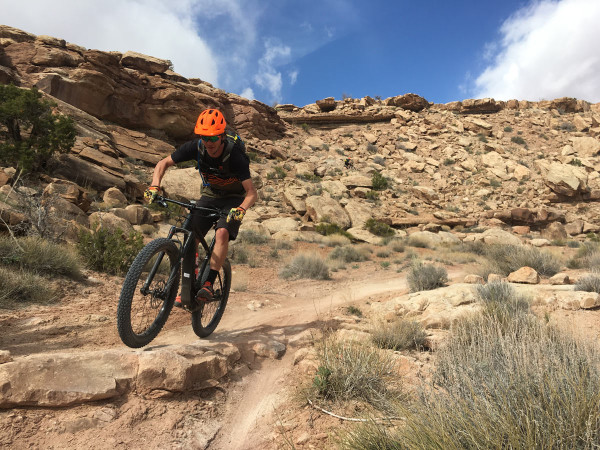
Also, in spite of the bigger tires and motors, no one was sending plumes of roost off the back tires. While riding the Sovereign trail system it was often hard to make out where the riders ahead had gone in spite of the sandy trail surface. The Levo certainly allowed us to cruise at ridiculous speeds on the pavement, but once on the trail, normal trail obstacles made it difficult to maintain anything other than slightly higher than average speeds except on few of the less technical climbs. On the climb up Amasa Back our speed never got much past 12 mph with the average closer to 6 or 7. And that was with a group of extremely talented riders pushing each other to the summit.
Honestly, this was an extremely difficult post to write knowing the cauldron of hate that e-bikes seem to stir. But trying to remain completely objective here, throw a leg over the Levo and you’re going to have fun. There’s really no way around it unless you are lying to yourself. Every rider who approached us at the trail head at first couldn’t figure out what it was. Then realization set in, and we encouraged them to take a spin for our own sake more than anything, paying close attention to their reaction. They all came back with a big grin, some even joking about trading in their classic bike. This is one of those things you really do have to try in order to understand it.
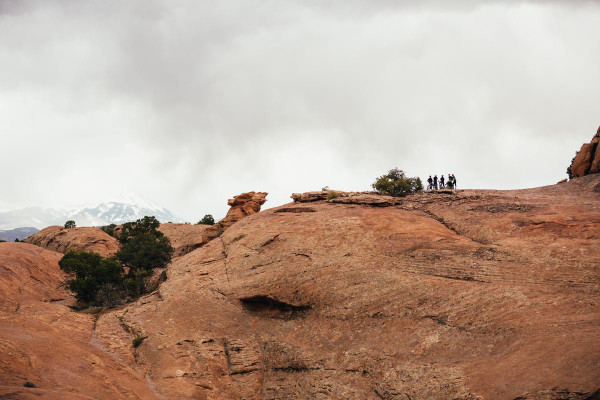
Fun aside, is this really a mountain bike? Does it belong on non-motorized trails? Personally, I’m fine with their current restrictions to OHV trail use only. A place like Moab made it clear that just because we weren’t on mountain bike specific trails it didn’t mean it wasn’t fun. In fact, I think the nature of the OHV trails may have suited the e-bikes more. Riding Slickrock on an e-bike will forever alter your opinion of the infamous trail.
Of all of the arguments against e-bikes though, I think the trail access issue is one of the few that does have a lot of merit. If you’ve been around mountain biking for any length of time, you know that trail access is a contentious issue and that an army of great people are constantly working to improve that. At this point in time, it seems that adding e-bikes to the mix would unnecessarily complicate things. Perhaps in the future when non-motorized mountain bikes are no longer viewed as the enemy to Wilderness, e-bikes could possibly gain acceptance, but for now it seems like the obvious answer is to keep them to motorized, off road vehicle trails.
However, even if e-bikes are kept to OHV trail use, we still foresee issues in the future. For starters, the Turbo Levo hardly looks like an e-bike at all, and e-bikes are only going to get more stealthy. That makes the act of enforcing trail use much more difficult for those in charge. As the history of mountain biking (and Strava use) shows, trails are still poached to this day by ‘classic’ bikes, so would e-bikes be any different? And even if trails aren’t intentionally poached, we have to figure that there would be a number of riders who purchase an e-bike and simply aren’t aware of trail restrictions and end up violating the rules even if they have no intention to. Specialized does make a plea to potential users that they follow the rules and stay on e-bike legal trails.
All of this left us still a bit unsure of the future of e-bikes off road in the United States. Our time with the Turbo Levo was undeniably fun and destroyed many of the misconceptions surrounding electric bikes, but still left us worried about potential trail conflicts. Even if confined to OHV trails (and streets), e-bikes will more than likely open the door to a new group of enthusiasts who may never find themselves on a classic bike – or enthusiast riders looking for the ability to ride more miles in a day. Of course this would greatly benefit companies like Specialized and others who are selling e-bikes which is certainly part of the equation and needs to be kept in mind. In the long term we just have to make sure that what’s good for the industry, is also good for the sport.
